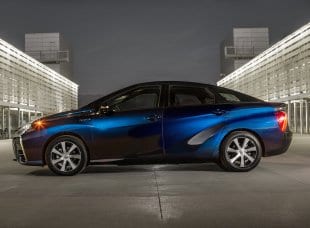 Japan’s push to develop hydrogen storage technologies may get a boost from Toyota’s decision to give away its fuel-cell patents.
Japan’s push to develop hydrogen storage technologies may get a boost from Toyota’s decision to give away its fuel-cell patents.
The auto giant offered up nearly 6,000 fuel-cell patents last month “to increase performance, reduce costs, and attract a much broader market of buyers,” said Toyota senior vice president Robert Carter.
Toyota, which leads the hybrid auto sector with the Prius, began selling its first fuel-cell car, the Mirai (which means “future” in Japanese), in Japan last December. It plans to make the $57,500 sedan available in California and selected European markets later this year.
The patent giveaway could be interpreted as a bid to head off a competitive threat from Tesla, which is betting on battery technology and has also opened up its intellectual property assets to third parties.
Formerly commercial partners in the development of the RAV4 electric sports-utility vehicle, the two companies parted ways in October. Tellingly, the Mirai is priced significantly below Tesla’s Model S, which retails for around $70,000.
However, another reading of the situation is that Toyota is responding to interest in the hydrogen economy in its home market. By December 2014, there were 100,000 residential hydrogen fuel cells already installed across Japan.
The nation is aiming for 5.3 million households, or roughly one in 10, to have fuel cells by 2030. Manufacturers such as Panasonic are leading the charge to release compact and cost-effective products for the residential market.
Residential energy storage was given an additional boost last month with a stimulus package worth $700 million. But transportation is where Japan is making its strongest hydrogen bet. All the major Japanese automakers have fuel-cell models.
Toyota, which was originally planning to build just 700 Mirais this year, is mulling an increase in production after getting 1,500 orders in a month. About 60 percent of these are from Japanese government offices and corporate fleets.
Prime Minister Shinzō Abe, one of the world’s first Mirai owners, says he wants all his ministries and agencies to adopt fuel-cell vehicles. To help sales, Japan is introducing a massive subsidy program worth up to 3 million yen ($25,550) per purchase.
This is more than three times the 950,000 yen being offered to prospective owners of Mitsubishi’s i-MiEV electric car.
Refueling ease is another reason Japanese consumers are increasingly choosing hydrogen. Car owners can top up a hydrogen tank within about five minutes, compared to the two hours or so that it can take to recharge lithium-ion car batteries.
Finally, the Mirai comes with a range of about 430 miles per tank, beating electric models. The Model S has a range of about 265 miles.
On the other hand, hydrogen fuel costs more per mile than driving an electric car or even a hybrid. And an electric car can, in theory, be charged from any standard power socket, while fuel-cell vehicle owners are dependent on the availability of hydrogen filling stations.
To deal with this, Abe last month said Japan will support the introduction of 100 self-service refueling points this year, as well as easing fuel-cell regulations. No further details have been announced. But hydrogen infrastructure suppliers are already taking positions in the market.
Air Liquide of France, for example, last month trumpeted the completion of its fourth and fifth hydrogen filling station projects on Japanese soil.
JX Nippon Oil & Energy Corp., meanwhile, opened its first filling station in December and plans to have 40 by March of next year, according to Japan Times. Tokyo Gas Co. and Iwatani Corp. also unveiled their first filling stations last year.
The stations currently cost four or five times more than a traditional gas station, so a priority for these companies will be to cut the construction and operating costs of the facilities.
Iwatani is looking to partner with 7-Eleven Japan to offer hydrogen refueling at convenience stores.
Safety will be another challenge. Tesla’s Elon Musk has slammed fuel cells on safety grounds, saying: “Hydrogen is a quite dangerous gas. It’s suitable for the upper-stage rocket, but not for cars.”
Nevertheless, according to Per Christer Lund, a DNV GL energy consultant, “Japan is world-leading now in using hydrogen as part of the system.”
Abe is keen for Japan to show off its hydrogen technology credentials at the Tokyo 2020 Olympics, Lund points out. And the push for residential fuel cells could benefit the auto sector by giving consumers a hydrogen refueling point at home.
“There will be much focus on fuel cells, both in the car industry and with hydrogen fuel-cell ships on the coast and on the rivers in Tokyo,” Lund predicts. “Japan has a big strategy and big budgets for hydrogen as an energy carrier.”
Source: Greentech Media. Reproduced with permission.








